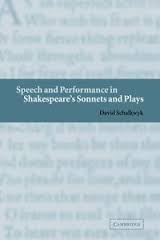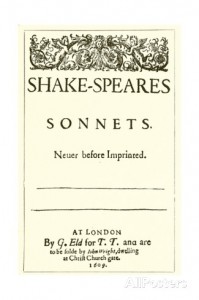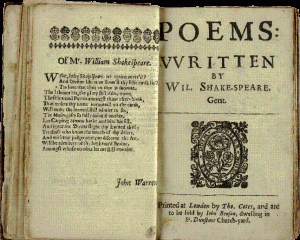I’ve only occasionally written in this blog about Shakespeare’s Sonnets, and then mostly about possible biographical references in them, for instance to Anne Hathaway or to the death of his son Hamnet. These are hard to avoid: for hundreds of years now people have attempted to make a coherent story from the sequence of poems that received their unauthorised publication in 1609. Was there really a Dark Lady and a Fair Youth who were involved in a triangular relationship including Shakespeare? Hundreds of books must have been written trying to establish their identity. Then there is the intriguing nature of the publication itself. Was it authorized by Shakespeare? (It’s assumed not). What role was taken by Thomas Thorp (named as TT on the title page)? And who is the “onlie begetter”, Mr W H?
Questions abounded, and weren’t helped by subsequent publication history. The second, 1640 edition of the sonnets omitted some, re-ordered them, sometimes combining two sonnets into one, made them more acceptably by occasionally making “he”, “she”, and giving them titles such as “The glory of beauty”. There’s an examination of the Folger Shakespeare Library’s copies of this edition here.
No critical edition of the sonnets was available until Malone’s was published in 1780, so many readers encountered these poems only in the 1640 format. It was in the Romantic period that the idea of the sonnets being autobiographical took hold, Wordsworth famously claiming “with this same key Shakespeare unlocked his heart.” Opinions varied. Nicholaus Delius, in the middle of the nineteenth century, called them “the free outcome of a poetic imagination,” and William Minto, some years later, regarded many as “exercises of skill, undertaken in a spirit of wanton defiance and derision of the commonplace.”
 Earlier this week Professor David Schalkwyk gave a lecture to the Stratford Shakespeare Club on the subject of the sonnets. He insists of looking at them as poetry rather than concealed autobiography. He has written many times about the sonnets, including his 2002 book Speech and Performance in Shakespeare’s Sonnets and Plays, Shakespeare, Love and Service, published in 2008 and 2013’s book The conceptual investigations of Shakespeare’s sonnets.
Earlier this week Professor David Schalkwyk gave a lecture to the Stratford Shakespeare Club on the subject of the sonnets. He insists of looking at them as poetry rather than concealed autobiography. He has written many times about the sonnets, including his 2002 book Speech and Performance in Shakespeare’s Sonnets and Plays, Shakespeare, Love and Service, published in 2008 and 2013’s book The conceptual investigations of Shakespeare’s sonnets.
Professor Schalkwyk began by asking who is the “I” in the sonnets? Whose voice are we hearing, and who is “you” or “thou”? These personal pronouns are non-specific and can be appropriated by anyone. Shakespeare assumes the persona of the poet, who in his turn plays, as he was to say elsewhere, “many parts”. There’s always someone else there, and the situation for virtually all the sonnets is a discussion or argument. The relationship between these people varies, from the authoritarianism of parent and child, master and servant, or the equality of friends, the uncertainty of lovers.
In his book The Genius of Shakespeare Jonathan Bate suggests the poems are persuasive because of what they leave out. “Since the poems imply a plot without actually spelling it out, there is room for readers to step in with their version of affairs. As the plays leave interpretive space for the audience …so the sonnets drop hints to draw the reader into their implied narrative”.
Both Bate and Schalkwyk made this connection between Shakespeare as writer of plays and the ways in which the sonnets work. He gives us the emotion of a siutation, and we are free to imagine an infinite number of appropriate scenarios. As Bate puts it, “This, then, is the genius of the sonnets: their power to generate readings”.
David Schalkwyk took as a powerful example sonnet 116, the sonnet frequently read at weddings. I’ve always felt uneasy at this, because the first four lines are awkwardly phrased, full of unsettling negatives. He suggested that rather than a confirmation of perfect love, it can be read as part of a lovers’ row, where one partner is threatening to leave a relationship and the other is determined to win the argument. His angry delivery was very persuasive. In his opinion, it’s definitely not suitable for a marriage. Here it is:
Let me not to the marriage of true minds
Admit impediments. Love is not love
Which alters when it alteration finds,
Or bends with the remover to remove:
O no; it is an ever-fixed mark,
That looks on tempests, and is never shaken;
It is the star to every wandering bark,
Whose worth’s unknown, although his height be taken.
Love’s not Time’s fool, though rosy lips and cheeks
Within his bending sickle’s compass come;
Love alters not with his brief hours and weeks,
But bears it out even to the edge of doom.
If this be error and upon me proved,
I never writ, nor no man ever loved.
The mystery of the sonnets remains. It isn’t even known when they were written, though the high point for sonnet sequences was the 1590s when Philip Sidney’s posthumously published Astrophel and Stella was followed by sonnets written by others including Fulke Greville and Edmund Spenser. Professor Schalkwyk has found that of the 154 Shakespeare’s sonnets, only 26 are collected into modern verse anthologies. This may be only 15% of them, but it’s considerably more than we remember of any of the others, and they’re remembered for their excellence as poems, not for what they might or might not reveal about Shakespeare’s life.




It never ceases to amaze me how ambiguous (in the best sense of the word) Shakespeare’s works are – how rich and multi-dimensional he expresses ideas. Not a black and white literary expression, but words that can be interpreted on many layers. And I believe Sonnets (which at first glance might seem very straighforward expressions of love) are great examples of this kind of complexity.
Thanks for your comment George. You’ll see in my forthcoming post about Hilary Mantel’s books what she has to say about how creative writers write.
if the author meant for the Sonnets to be read and considered just as poems but if the author did not intend that they should be published, are not these hypotheticals mutually exclusive, thus completely inadequate as explanations of the poems?
I would like to have it explained why twenty-four of forty-seven critical words that appeared in Laura Crowley’s discovered text, Southampton’s appeal to Elizabeth I (Feb. 1601) to spare his life, also appeared in closely situated Sonnets of “Shakespeare”. The duplicative words “trespass, treason, ransom, misprision, fault, and felony” in both documents exceed random coincidence.
It is particularly curious that Sonnet 45 reads: “Those swift messengers returned from thee/ Who even but now come back again assured/ Of thy fair health recounting it to me.” Southampton was seriously ill during his imprisonment, and the Sonnets author knew it. Such words of concern and privileged knowledge do not apply to everyone everywhere, meaning everything and nothing.
Ms Morris’s statement that few (26) of the 154 Sonnets are anthologized simply supports the specificity of the poem sequence dealing with a specificity of experience not yet comprehended or admitted.
As T.S. Eliot wrote, “This autobiography was written by a foreign man in a foreign tongue that can never be translated.” Apparently HE did not feel they were abstract creations to draw the reader in. He knew them to reflect a man’s life and just admitted he lacked knowing whose.
The other Sonnets than the anthologized ones (26) are just as “excellent as poems” as the selected minority. But the point is not that they don’t say as much as that minority group, but that they say too much for habituated ears.
Dear Sylvia,
You mention having written about possible biographical references to the death of Hamnet in the sonnets. I’ve searched your blog and not found any reference. This is of particular interest to me. To me Sonnet 33 seems to refer to the death of a son. It even puns ideationally on the word “son”. That is, the Sonnet concerns the appearance and (tragic) disappearance of the “sun”. It then personifies the sun. It may reflect the limit of my reading, but I’ve only read commentary which groups this sonnet with the “fair youth” relationship, rather than as a father son. Similarly Sonnet 43 seems most poignant in the context of the death of a child. I’d be very interested to hear your views on these two, or for your direction to any commentary along this line.
All the best
Bruce
Dear Bruce
The reference appears in this post https://theshakespeareblog.com/2012/06/the-case-for-anne-hathaway/, and it is, as you guessed to Sonnet 33. Thanks for your comment and well done for trawling through the blog posts (over 450 now written).
Dear Sylvia
Thank you for the pointer. I understand there was not the mutual mistrust between the arts and mathematics in Renaissance times. I find 33 interesting because at its heart is an ideational pun on “son” (i.e. the word “son” does not appear in the sonnet). The S of SON (in the word “sonnet”) is the 33rd letter of the dedication. There seem to be quite a number of similar alignments between words in the dedication and individual sonnets – which I hope I’m not imagining.
The possible reference to Anne Hathaway in 145 is intriguing, particularly with the additional fillip that the pronunciation of “and” may be softened to “Anne”. I have wondered too whether, being the only sonnet in tetrameter, he is poking fun at someone’s use of this metre, so there may be a pun on “eight”. I think tetrameters were referred to as “eights”. We could then have “I eight” and “my woefullest eight”. The pentameter (Shakespeare’s preferred metre) is restored with the additional iamb (“I am”?) – “not you”.
Thanks again for your response and your very interesting blog.
Bruce
I can’t recommend too highly the splendid “Reading Shakespeare’s Sonnets” by the Scottish poet Don Paterson. It’s a splendid way into the sonnets.
Bill, Thanks for your comment. I don’t know Don Paterson’s book, but a poet’s perspective is sure to be interesting.